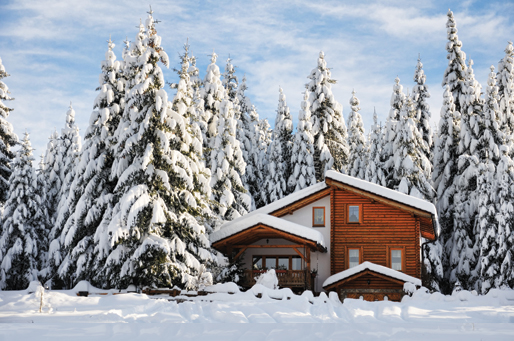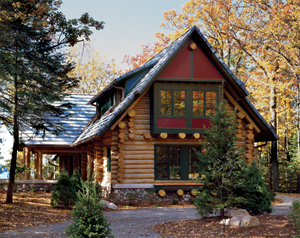There was a time in the not-too-distant past when regional log availability and building techniques dictated the types of homes that one could build in specific areas of the United States. Round logs were prevalent in the Northeast and in certain Midwestern states while square log homes with dovetail corners dominated in the Appalachian region, including the Virginias and the Carolinas. Adirondack homes were large, but were made from smaller logs that are indigenous to the region, while Pacific Northwest structures were built with large, round logs and featured expansive, overhanging roofs.
Fast-forward to 2012 and those regional restrictions have mostly been eliminated, leaving consumers to choose from a much larger selection of homes, regardless of location. While the availability of certain wood species and sizes continues to play a role in the final selection process, consumers are free to go beyond the traditional barriers to build the home of their dreams.
A Bit of History
Early American settlers were especially fond of log homes. They were easy to build using the natural resources surrounding the settlement areas. “The materials were readily available to make structurally sound homes that were warm and that kept the bears out,” says Lynn Gastineau, president of Gastineau Log Homes in New Bloomfield, Missouri. As time progressed a trend emerged: the log home style associated with a specific region was largely based on the types of trees that were indigenous to that area.
In the Blue Ridge Mountains of North Carolina and in the Appalachian mountain region, for example, large hardwood trees tend to dominate the landscape. Too big to use as a single piece, the logs had to be hewn and made flat on two sides in order to be suitable for building. During that hewing process a large chunk of log was removed and the corners were notched. The logs were then stacked and the spaces between them filled with chinking that weatherproofed the homes and kept them warm in the winter.

This foundational approach to log home building paved the way for the regional options that homeowners had to choose from. “Basically, builders developed houses based on the best timber that was readily available,” Gastineau explains. The same approach rolled out across the United States, where Rocky Mountain log homes were built with pine and fir trees of smaller diameter than their East Coast cousins. Working with 40- to 60-foot-tall trees, Gastineau says the easiest approach was to notch the ends out of the logs in the corners, stack them, chink them, and “build the walls upward from there.” The process resulted in the round log look that’s prevalent in the Rocky Mountain region.
Log homes throughout the rest of the country offer slight variations from those two dominant construction types. And even though consumers have more choices in front of them than the early American settlers did, Gastineau says factoring an area’s indigenous wood species into the equation is usually a smart move.
“Look at the species and the regional climate,” says Gastineau. “An untreated pine log is going to require a lot more maintenance and a lot more chemicals in Louisiana or Texas than the same pine log would need in Idaho because of the difference in the climate.” After all, Gastineau adds, “We don’t make log homes, Mother Nature does. We just cut ‘em.”

Maple Island Log Homes/photo by Roger Wade
Expansive Options
When it comes time to select your log home’s style, Gastineau says location doesn’t necessarily minimize your options. In fact, she says that modern technology and equipment improvements have helped log home producers offer up a wider selection than ever.
Dana Delano, director of sales and marketing at Ward Cedar Log Homes in Houlton, Maine, concurs. “These days pretty much any log home firm handles a wide range of style options, primarily so that customers don’t go somewhere else to get what they want,” he says. “The trend to diversity and providing more choices has been largely driven by the customer.”
Even so, there are still some regional differences among log cabin home style choices. Those situated in the Northeast tend to be more “formal,” says Delano, and typically incorporate D-shaped logs (versus round). “Those logs provide the warmth of wood while fulfilling the desire for a more formal look.”
Moving farther south into Tennessee and West Virginia, the styles morph somewhat, but still incorporate traditional dovetail corners with chinking. In Midwestern states like Missouri and Illinois, Gastineau says oak log homes tend to dominate, with most of the older structures built on the “chinked, dovetailed, hand-hewn” philosophy. Log homes in Wisconsin, on the other hand, are primarily made of round pine logs that are saddle-notched and chinked.
It’s Your Choice
If you’re trying to figure out what type of log home will be best suited for your region, Delano says a good first step is to take a look around and see what’s already built and what styles and timber types are most prevalent. Factor that information into your final decision, he says, but don’t be put off by the fact that your dream home design isn’t already present in the area where you plan to build.
“Go with what makes you happy, even if it doesn’t include the D-shaped logs that all of the other homes in your region were constructed with,” says Delano. “There are some distinct differences as you move throughout the country, but in the end it’s really up to you.”
Gastineau says that in most cases the preferences of the homeowner can be matched with regional timber availability and typical construction styles. “These days people pretty much are building what they want where they want it,” Gastineau says. “Certain styles are still prevalent in specific regions, but at the end of the day it comes down to what the homeowner wants.”
Photography by Roger Wade Studio


